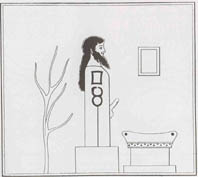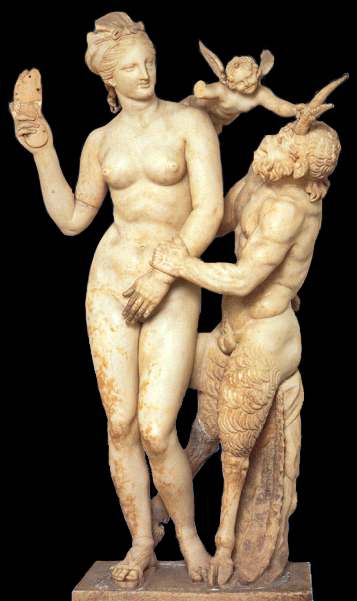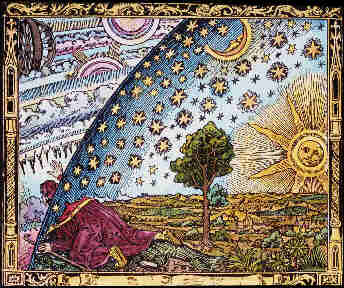4.4
Carl Jung’s divine/human double quaternity versus the Eros
Self and the matter-psyche
4.4.1
The depth psychologist’s Neoplatonic interpretation of the unio corporalis and the repression of conscious suffering
When
we go on reading about the monocolus or uniped in the Mysterium Coniunctionis we are amazed that Carl Jung does not follow
this Hermetic interpretation of the unio
corporalis – the death of the Logos king as the necessary
condition of a further development – anymore, but returns to
the Neoplatonic of the unio
mentalis. He writes literally:
“From
all this it appears that our picture [of the monocolus]
represents the
union of the spirit with material reality. [emphasis
mine]
This conclusion
summarizes the discussion of the 7th picture
presented above (see section
4.3.2). Carl Jung’s
interpretation begins in § 724, and in § 725 he states already:
“This picture represents the union of the monocolus with the
earth (the body).”

 This
Holy Wedding has dramatic effects. The king in former times
brightly golden and dressed in a safran-yellow robe
“has now
become totally black – the sol
niger” (§ 725). Thus, he is labelled as the
“black Osiris or Ethiopian, and also [as] the ‘Moor’” (§
730). The head of this black Osiris is „boiled in a pot“ (§
730). For this reason the royal personages have to be
decapitated (§ 730). This headlessness suits very well to the
circumstance that the monocolus as well as Osiris as a general
rule are represented ithyphallically (§ 726) [as also Hermes;
see figure on the left]
and in the Christian interpretation therefore compared with the
devil (§ 726). Of course this figure is not the Christian devil,
but close to the cosmic God Pan (see figure on the right: Pan with
Aphrodite and -- Eros).
This
Holy Wedding has dramatic effects. The king in former times
brightly golden and dressed in a safran-yellow robe
“has now
become totally black – the sol
niger” (§ 725). Thus, he is labelled as the
“black Osiris or Ethiopian, and also [as] the ‘Moor’” (§
730). The head of this black Osiris is „boiled in a pot“ (§
730). For this reason the royal personages have to be
decapitated (§ 730). This headlessness suits very well to the
circumstance that the monocolus as well as Osiris as a general
rule are represented ithyphallically (§ 726) [as also Hermes;
see figure on the left]
and in the Christian interpretation therefore compared with the
devil (§ 726). Of course this figure is not the Christian devil,
but close to the cosmic God Pan (see figure on the right: Pan with
Aphrodite and -- Eros).
This
state of blackness in which “the sun is surrounded by the anima media natura” [the
world soul] Carl Jung interprets as “a state of incubation and
pregnancy” (§ 729). Thus we are very astonished by the
subsequent remark that the beheading is “an emancipation of
the ‘cogitatio’ [cognition] which is situated in the head”
(§ 730), which is in modern terms obviously the conscious
development of the thinking function. Like this the decapitation
becomes “significant symbolically as the separation of the
‘understanding’ from the ‘great suffering and grief’”
(§ 730). Therefore, it seems that conscious suffering is
substituted by thinking, a procedure which is “a freeing of
the soul from the ‘trammels of nature’” (§ 730)! This
“sublimation” of the suffering into thinking is then, after
the depth psychologist, the “unio mentalis ‘in the overcoming of the body’” (§ 730) [“in
superatione corporis” in the German original].
Such
a translation of the alchemical procedure of the beheading into
a modern language – the “extraction” of the thinking
function, and thus the interpretation of the process as the unio
mentalis – is very amazing, above all also since the
alchemical procedure serves the creation of the rotundum,
the “round man” (§ 731), the Anthropos or God-man, the very
last goal of the opus. Four years before, in his work AION,
Carl Jung had however equated the Anthropos and the rotundum with the world soul.
What the thinking function of consciousness should have to do
with the principle of universal animation is more than obscure,
and also the circumstance that magical practices are necessary
to complete the task successfully (§ 731) does not suit to the
rational thinking function. Further, the development of the
thinking function is not really encouraged by another necessary
procedure, in which the brain is darkened “with very strong
vinegar, or with the boy’s urine” (§ 733).
The depth psychologist interprets like this the
alchemical magical procedure of the production of the so-called caput
corvi, the Raven’s Head (§ 729). Though it represents on
the one hand the human head (§ 731), it is on the other
equivalent to the head of the black Osiris (§ 730) or Ethiopian,
and thus to the black sun, i.e., the eclipse of sun and  moon in
the unio corporalis (see above). Since it is round, this black head
belongs to the Anthropos and thus to the world soul, and not as
Carl Jung proposes, to the conscious sensation function, the
five senses to be developed (§ 732). In a psychological
language the head of Osiris belongs therefore to a “darkening
of thinking”, the latter necessary for the transformation of
the Logos ego into the Eros ego I suggest. In this state it is
possible to open “the other window”,
the
(deeply introverted) vegetative sensation
(Definition see in
section 5.4.3)
which
is able to have a look out of the fenestra
aeternitatis or to sensate the spiraculum
aeternitatis, i.e. make it possible to learn to relate to
the unus mundus
(see picture on the right).
moon in
the unio corporalis (see above). Since it is round, this black head
belongs to the Anthropos and thus to the world soul, and not as
Carl Jung proposes, to the conscious sensation function, the
five senses to be developed (§ 732). In a psychological
language the head of Osiris belongs therefore to a “darkening
of thinking”, the latter necessary for the transformation of
the Logos ego into the Eros ego I suggest. In this state it is
possible to open “the other window”,
the
(deeply introverted) vegetative sensation
(Definition see in
section 5.4.3)
which
is able to have a look out of the fenestra
aeternitatis or to sensate the spiraculum
aeternitatis, i.e. make it possible to learn to relate to
the unus mundus
(see picture on the right).
In
my estimation of Carl Jung’s work the above conclusions are
the absolutely decisive ones. In them the depth psychologist
replaces the “great suffering and grief” by thinking and
extraverted sensation and regresses like this back into the unio
mentalis, i.e., Active Imagination. This is the reason why
he cannot advance to the unio
corporalis, in which thinking is consciously suppressed for
the purpose of the conscious suffering. In fact, what he
proposes is a repression of the (inferior) feeling function –
exactly the contrary he demands for the creation of the
wholeness of the quaternarian consciousness.
On
the contrary, in my opinion, in exactly this moment, the
thinking type – and in fact any type – is not allowed to
“sublimate” the suffering and to repress the negative
feelings by transforming them with the help of Active
Imagination into a cognition. No “creation by cognition”
is announced here, but a “creation by observation,”
in which the imaginating consciousness just observes in a state
of the Wu Wei, the active passiveness, what happens in its
inside and in the body.
The
reader may decide for themselves what to think – or better
feel – about my above statement. It is a conclusion that comes
from the background of my own and also from the experiences with
my patients. Therefore, I for my part am convinced that the
depth psychologist’s interpretation of the monocolus as the
thinking function to be developed is inadmissible. In this
moment of the transition from the unio
mentalis to the unio
corporalis the further development of the conscious
spirit-psyche, and thus Carl Jung’s interpretation of the
monocolus, the “uniped” is out of place. The ithyphallic Osiris and the
dying king of Hermetic alchemy, the vegetative god of the
underworld belonging to the sol
niger, the obscured Logos principle we have much more to
compare with Purusha,
the Hindu god of creation –
living in the heart of the humans – , dismembered for the goal
of a new creation. It is the Anthropos or the world soul who
initiates by their suffering a vegetative creation and
incarnation process not based on the spirit-psychic background
and producing new ideas, but on the intermediate realm of the
matter-psyche, of the world soul in the macrocosmic and the body
soul in the microcosmic case. By such a co-suffering
of the introverted consciousness with the dying god, with
Osiris or Purusha, and also with the dying nature of today, an
introverted creation by observation – compensatory to the
creation by cognition of depth psychology as well as of science
– is possible, which could perhaps compensate the threatening
danger of the total destruction of nature and of mankind in the
anticipated apocalypse of the near future.
4.4.2 The
coniunctio in the Christian Heaven
In section 4.1 I
have demonstrated that the falling dew of the Rosarium
corresponds to the above process. The psyche abandons the
spirit, and the latter dies. For Carl Jung, however, it is the
spirit and not the “spiritualized” psyche coming down from
heaven that unifies with the “earth” or matter. The depth
psychologist’s spirit is what I call the spirit-psyche, the
product of the first coniunctio
or unio mentalis, the
Logos principle seated in Heaven. We can therefore conclude that
in his interpretation of the unio
corporalis or the second coniunctio,
the god remains in the realm of Heaven. Like this, the king of
Logos neither enters the grave, the womb of the queen
– he does not die. In Carl Jung’s interpretation, there is
thus no continuation of the sexual myth of the Rosarium
with a vegetative opus necessary for the creation of the lily,
the Seal of Solomon, the red tincture, the infans
solaris – shortly: the quintessence.
As
a logical consequence the depth psychologist continues as
follows:
“It
is not the common gold that enters into combination but the
spirit of the gold, only the right half of the
king, so to speak. The queen is a sulphur, like him
an extract or spirit of earth or water, and therefore a chthonic
spirit. The ‘male’ spirit corresponds to
Dorn’s substancia
coelestis, that is, to knowledge of the inner light – the self
or imago Dei which is here united with its chthonic counterpart,
the feminine spirit of the unconscious.” [emphasis
mine]
Shortly before, the
queen was still the “material reality”, but now, in these
decisive sentences, she mutates into “a chthonic spirit” or “the feminine spirit
of the unconscious.” Therefore, the wedding happens in the
realm of the spirit, in Heaven, and not in the intermediary
realm between Heaven and earth, between spirit and matter, of
Robert Fludd and Gerardus Dorneus!
The
logical conclusion of such a marriage neither instinctive nor
vegetative, but happening in the virginal realm of the pure
spirit, is of course that the real feminine principle, the
matter-psyche, the “chthonic Trinity” (Wolfgang Pauli),
the “anima vegetativa, the ‘ligament’ of body and spirit”
(Jung), the threefold goddess of the Greek underworld –
Demeter, Persephone and Hekate – or the tripartite goddess of
the Celts, i.e., the lower triangle of the Seal of Solomon, is
excluded.
4.4.3 The Holy Wedding as the relationship of the
Anima with the Self and of the ego with the Anima
Therefore, Carl Jung continues his interpretation
of the unio corporalis
as follows:
“Empirically [the feminine spirit of the
unconscious] is personified
in the psychological anima figure, who is not to be confused
with the ‘anima’ of our mediaeval philosophers, which was
merely a philosophical anima vegetativa, the ‘ligament’ of
body and spirit. It is, rather, the alchemical
queen who corresponds to the psychological anima.”
[emphasis mine]
As we have seen,
the alchemical figure of the queen or goddess is on a par with
the king or the god; they are equivalent. Today we would say
that the queen is emancipated. But in Jung’s world view the
goddess is now discriminated against by the god; the god is of a
higher value than the goddess. The latter becomes the Anima, the
mediator between the ego and the Self, somehow settled in an
intermediate region between the (Logos) consciousness and the
depth psychologist’s God-image, the (Logos) Self, and not in
the intermediary realm between the principle of the spirit and
the opposite principle of matter.
One would now
assume that this extension of the God-image is the goal of Carl
Jung’s interpretation of the unio
corporalis. Therefore it is very astonishing that he
continues now as follows:
“Accordingly,
the
coniunctio [the unio
corporalis] appears here as the union of a consciousness (spirit),
differentiated by self-knowledge, with a spirit abstracted from
previously unconscious contents. One could also regard the
latter as a quintessence of fantasy-images that enter
consciousness either spontaneously or through active imagination
and, in their totality, represent a moral or intellectual
viewpoint contrasting with, or compensating, that of
consciousness. To begin with, however, these images are anything
but ‘moral’ or ‘intellectual’; they are more or less concrete
visualizations that first have to be interpreted.”
[emphasis mine]
It
is obvious that “the consciousness differentiated by
self-knowledge” is the result of Active Imagination, since it
is, as we have seen above, exactly this imagination method that
helps to differentiate the consciousness into the quaternity of
the four functions thinking, intuition, sensation and feeling
and to integrate the personal shadow. The “spirit abstracted
from previously unconscious contents” seems to be the Anima,
defined by Jung as the chthonic spirit. Therefore, the God-image
is now replaced by the quaternarian consciousness and its
relationship with the Anima. The tool for this relationship is
again Active Imagination.
Like
this we can conclude that the unio
corporalis, the phase in which the dying god comes down and
the goddess arises for their meeting in the middle, in the
intermediary realm of the unus mundus, mutates in Carl Jung’s
view on the one hand into the union of the Self with the Anima,
on the other into the union of the Anima with the ego. The
structure of this idea is however nothing else than the double
quaternity proposed by the depth psychologist: The
differentiated consciousness is build as a (3+1) structure,
since the inferior function is somehow outside, not controllable
and thus the connection to the Anima. The Self on the other hand
is also defined as a (3+1) structure, i.e., Carl Jung’s
God-image of the Christian Trinity extended by the addition of
the Anima.
If
we believe in the depth psychologist’s interpretation, the
“previously unconscious contents” are “the quintessence of
fantasy-images.” This “quintessence” – as an image not
belonging to the spirit-psyche in Heaven but being very close to
the instincts and the human body – does however, in Carl
Jung’s view, not have any worth in itself; on the contrary it
seems to be “anything than ‘moral’ or ‘intellectual’”,
and thus has first to be interpreted, i.e., transformed into a
meaningful verbal language. It is exactly this process I
described as the creation by cognition.
Further,
since the goal is a moral and intellectual insight, it is
obvious that again the thinking function is needed to reach this
goal. Thus, we are back to the problem of Active Imagination we
discussed above: Carl Jung’s main conscious function is the
most important tool for doing the imagination method proposed by
him.
But how about the fact that perhaps three quarters of
mankind are not of this typology. Do they not rape themselves by
trying to do Active Imagination? Is it not possible that the
“visualizations” Carl Jung mentions, could have, in contrast
to the Neoplatonic prejudice, a great value in themselves? Could
it be that these inner images mostly experienced much more
corporeal than dreams, are a creation and incarnation in
themselves and need not necessarily be intellectually interpreted? Could
these spontaneous images not be a product of the unio
corporalis of the world soul with the seeds of the dead
Heavenly king happening in the intermediary realm of the unus
mundus? Could the quintessence not be what I call a
“unique inner quantum leap” we have only to observe and not
to interpret – the previously referred to creation by
observation – and help like this an incarnation of “new
life” in our space and time bound world? Are these “inner
radioactive decays” perhaps incarnations out of the unus
mundus
the Medieval alchemists experienced as a so-called creatio continua, compensatory to the creatio ex nihilo.
Thus, could such spontaneous incarnations possible at any
time and observed by a human being, be a compensation to the
unique creation of the world symbolically described in
Genesis and interpreted by science as what Carl Jung called the
“cheerless clockwork fantasy"?
Could perhaps God’s “unique big bang” be followed by other
ones out of the unus
mundus, the potential world before Genesis, observed by
specific human beings. Could such a hypothetical procedure
perhaps be the modern variant of Isaak Luria’s tikkun, Carl Jung was so fascinated with?
[proofread GJS, 11/18/05]
part
12